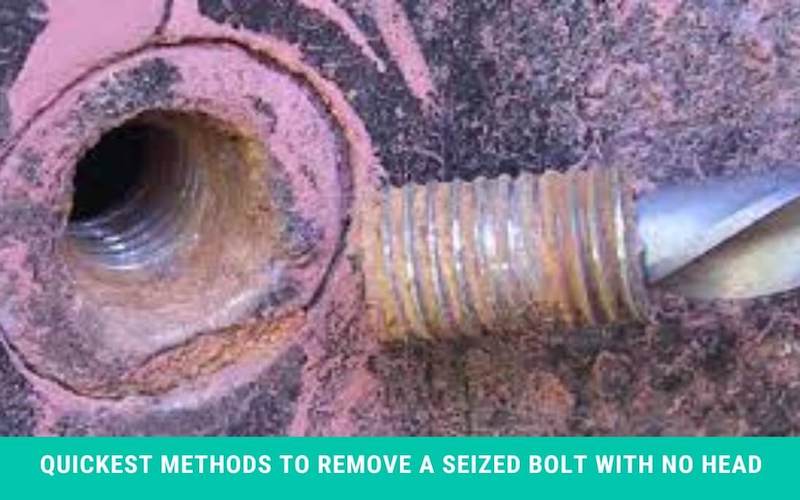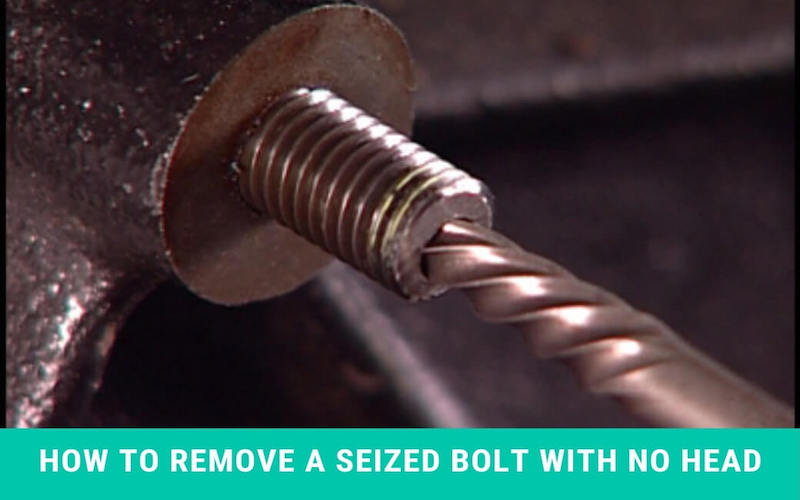When you drill on the DIY project, sometimes a bolt may break and it may seize inside the workpiece. So, it can be a matter of anxiety for the project owner how to remove a seized bolt with no head.
Most do-it-yourselfers with minimal abilities can take on this task. Patience is required when extracting the trapped bolts. Drilling through the bolt bottom with a small drill will relieve your pressure and may allow you to remove the remaining bolt.
If it doesn’t work for you, you can drill, thread, and then use the auxiliary spools to re-open the new spot to the current size. Therefore, let’s go deeper to choose the most effective one based on the state of the seized bolt with no head and effectively manage your home garage.
How To Remove A Seized Bolt With No Head
Suppose you have the right tools and know what you’re doing. The following is the simplest method for removing the seized bolt.
Step 1: Find out a problem with the bolt
First, examine the broken nut or bolt. A loosened bolt is on the verge of breaking.
Check to see whether the bolt is rusted or if it has a locking compound. Some manufacturers build their bolts with a heat soften-able thread locking.
Determine whether or not the rusty bolt is salvageable. A rusty bolt with low tensile strength can provide the required force. If this is the case, it is preferable to replace the bolt. Yet, you may generally salvage screws and bolts by using locking pliers on the J-nut.
Step 2: Remove the rust on the bolt
If you discover that the bolt is still usable, remove as much rust as possible from it. To make it easier and more effective, use a firm wire brush. An air compressor can swiftly remove the rust.
Step 3: Select the appropriate Tool
Select the best tools. Open-ended wrenches may help to raise the levels of a screw. A box containing six points is appropriate for a 12.4. On the other hand, the nuts may get smaller due to rust. Therefore the next lower size will fit better. Furthermore, you may trim the nuts off muffler fasteners using an abrasive wheel joint and a die grinder.
Step 4: Turn it the correct way up
Check sure you’re moving the bolt appropriately. Despite their extensive knowledge, some mechanics continue to make mistakes. They were particularly perplexed while operating in the upside-down and reverse orientations.
While most of the threads are loosened with the left hand, several lug nuts from the 1960s and some ring gear bolts are required to be turned backward.
Step 5: Thread loosener in liquid form
To unstick the rusty bolt, use a liquid thread loosener. To properly overcome the most excellent rust bond, you can also use penetrating oil from various manufacturers. Furthermore, you may combine 50 percent ATF with a home brew of 50 percent acetone as long as you are sheltered from the fumes they emit.
Step 6: Soaking The threads
Soak the threads thoroughly with penetrating oil now. Remember that it is critical to reapply applications and likely steep them fast. Simultaneously, patience is essential since it will save the time you would have spent drilling. You don’t even need a hammer drill.
Step 7: Increasing batter leverage
A breaking bar will provide you with more leverage. Use your effort with caution so that you can feel every turn. If the pressure suddenly becomes smooth, you will either peel the threads or damage the bolts. Put on protective gloves to alleviate aching knuckles.
Step 8: Make use of heat
Heat is required to dissolve the rust bond and melt the locking compound. Because oil is highly combustible, use the flame to wash off all oil before using it in a potentially explosive area.
Step 9: As a lubricant, use paraffin
When removing corroded pipe plugs from cast iron, many specialists employ this method—applying heat to the iron. They melted a candle over threads with the metal. At this point, paraffin coats the threads and acts as a lubricant. However, it must use the correct size and tight-fitting socket.
Step 10: The final solution
The last alternative is an electric impact cannon, which frequently kills the bolt. Safety gloves, spectacles, and suitable impact sockets are required for more giant nuts. If feasible, use the impact cannon on the wedged region while holding the bolts with a wrench.
Proper Maintenance
There are various things you can do to avoid having the bolts trapped in the first place. To avoid galvanic corrosion seizing, use a high-quality thread lubricant on the bolts or studs. You have to be cautious when tightening the bolts and avoid over-tightening them.
On the fastening head, use a wire brush. Anyway, rust may be prevented by simply spraying a layer of paint over the fastening heads. The color also keeps moisture out of the threads by blocking them.
When painting the heads isn’t possible, a frequent application of penetrating oil and a little dollop of grease is an option. If the bolt threads are exposed behind the bracket, it’s also good to use the same procedure.
Also Read: How to Remove A Broken Screw without An Extractor
Quickest Methods to Remove A Seized Bolt With No Head

There are several methods for attempting to extract a stuck bolt with no head. Let’s go through these ways with examples so you can learn how to loosen a seized bolt with no head.
Blunt Impact/Force
When trying to loosen difficult bolts, this usually is our first step. We consistently employ this approach before attempting to remove emission studs from a cylinder head. You may use several procedures.
One method is to use a chisel or punch to strike the middle of the bolt’s head. Another option is to use an impact wrench/gun and hit it reverse and forward a few times. Remember that you may combine it with various approaches to make the work simpler.
Relief or Comfort Cuts
In this manner, you will make 2 to 3 cuts in the bolt. The goal is to cut enough to get virtually through the bolt.
Then, a chisel and a hammer whack the cuts a few times, fracturing the bolt and alleviating the tension. You may now spin the bolt using pliers. Typically, the relief cuts allow the pliers to compress the bolt enough to get it out swiftly.
Heating
Heat the region surrounding the bolt to cause the hole into which it is threaded to expand and open up somewhat. It allows the bolt to fit a little looser and be threaded out.
When first splitting it open, use an impact wrench/gun since the pressure from the smashing of the impact wrench breaks the rust apart. To help in the removal process, use penetrants such as Kroil or CRC Freeze-Off.
Drill A Hole in the Seized Bolt
Drill through the bolt using a tiny drill bit. This makes use of some of the other approaches as well.
Drilling warms the bolt’s body and makes a hole in it, allowing it to compress further when you try to remove it. It will speed up the removal of the jammed bolt.

Remember that the drill should be slightly smaller than the size of the bolt. You may now carefully chisel or shatter the bolt inside the hole. After that, remove the parts and clear the threads from the hole.
Rock the Bolt
This is another strategy to attempt early in the process, in concert with others. Push the bolt or nut backward and forth with a ratchet and socket. Release the nut or bolt until there is some tension underneath it again, then spin it almost back to where you started.
Then loosen it a little more than the last time. Spray some penetrant on some of the exposed hidden threads so that the material will kick back into the concealed threads.
Using a Bolt Extractor
Several extractors are available on the market; you may use any decent one. To remove the bolt, they employ complex parts that slide inside it. You must be careful not to damage the extractor in the hole when using it; otherwise, you will be in big trouble.
Weld it together
When any nut or bolt head is severely stripped and cannot be turned with locking jaw pliers, or if the head has broken off the bolt, use this one. Tack weld a nut and a bolt of somewhat bigger size to the bolt body.
Cover the nut with weld, then run a bead around the base where it joins the bolt body once it’s tack welded. It allows you to re-socket the bolt and introduces heat into it, allowing it to expand, compress, and break some of the rust.
Chisel And Air Hammer
We use a chisel and an air hammer on the bolt to loosen it in this procedure. It works with middling success, although it is more effective if the bolt is in an open location.
FAQs
How to remove broken bolt in tight space?
If there isn’t enough room for removing the bolt, put a new one into the head. Welding heat helps to loosen your bolt. You can use mole grips or self-gripping pliers when you have enough space. You can also use a curve grinder to grate new levels on the bolt head. In case of enough room on the bolt’s one side to insert a chisel and hit that chisel using a hammer, choose a straight chisel similar to the head thickness.
How to remove broken bolt without extractor?
Drill a hole in the very center of the bolt and drill straight into the bolt center. Start with a tiny 3.4mm bit, then increase the diameter of the drill until you only see the threads of the bolt. Then use a sharp pen to remove the pieces of wire left in the bolt hole; you will be left with only the original wire. You can insert another bolt or in a different way. As the drilled hole gets more significant, use a flathead screwdriver to unscrew the broken bolt.
How to remove a broken bolt from an engine block?
The easiest way is to catch a sharp spike and a miniature hammer. With a center punch, just hit the outside of the bolt as distant as you can and tap slowly counterclockwise from that end. Anyway, it may move slowly at first, then lightly. Later, you may place your finger onto the bolt and loosen it. Following this, you can easily remove the 6mm bolts from the large engine block.
Final Verdict
Rust will accumulate on metal items over time, including your screws and bolts. Because these things are found in practically every human-made machine, device, and convenience, rusting them may be a significant issue. After these bolts have deteriorated, you must replace them in many cases.
So, if you haven’t any idea how to remove a seized bolt with no head, calling the pros will cost you a lot of time and money. So bear in mind the instructions we’ve provided and ensure correct application so you can enjoy trouble-free functioning and focus on developing rather than mending.
